At its core, financial literacy is about understanding how to keep your finances in a good place by managing your money properly. A financially literate person is one who is capable of making informed decisions about budgeting, saving, investing for the future, and handling debt. With that in mind, here’s a primer—“Personal Financial Literacy 101,”—to summarize the key elements you need to know.
Managing Your Income/Budgeting
Things tend to work more smoothly when they start with a plan. This is especially true for finances. Many of us have a set amount of cash coming in each month. Using that money strategically can ensure the effectiveness of other financial decisions.
A good first step is to create a list of all your monthly sources of income. Total them up to get an idea of how much cash you have to work with on a monthly basis.
The next step is to make a list of all monthly expenses to understand where that money goes. Doing so provides the ability to look for frivolous spending that could be put to more productive use; such as saving and acquiring the essentials you need without going into debt.
There are a number of tried and true budgeting methods. Some call for setting aside half of your income for needs, 30% for wants, and the remaining 20% for savings. However, there is no such thing as one-size-fits-all when it comes to budgeting. Finance experts at Wall Street Journal have created a list of some of the best budgeting approaches. Whichever strategy you choose, the key is to pick a manageable one—and stick with it.
People Also Read
Savings Accounts/Emergency Funds
Have you heard the fairy tale about the industrious squirrel that stored nuts all summer while the fanciful grasshopper chose to have fun? When winter came, the squirrel was well fed and the grasshopper starved.
However, far too many people do not see how that applies to everyday life.
Saving money is one of the most important building blocks of financial well-being. Moreover, you should have a variety of savings accounts to cover everything from future milestones to retirement. In addition to the traditional types most of us are familiar with, an emergency fund that covers three to six months of expenses should be included when creating the budget above.
According to the 2022 Personal Capital Wealth and Wellness Index, only 53% of Americans can handle an unforeseen $500 expense without having to scramble for the funds. Having an emergency fund can help you avoid debt should your income be interrupted, or the need for an unexpected expenditure arises.
While meeting expenses and saving simultaneously might seem like a daunting task, careful budgeting can help bring it to fruition.
Investing
This area of financing could take an entire course of study. However, the gist of it is using your money to make more money. Investing is a key means of building wealth, ensuring a comfortable retirement, and starting a legacy of generational wealth within families.
The most common means of investing are stocks, bonds, and mutual funds. There are numerous sources of information to help you get started but be careful. If you can’t afford to lose the money, don’t invest it in risky investments.
An oft-overlooked form of investing is purchasing a home rather than renting. Owning a home means building equity, as it typically increases in value over the years. When you think about it, renting can be considered throwing away money since you have nothing to show for it in the end.
Handling Debt
Debt is pretty much a given in modern society. Few people have the wherewithal to pay cash for a home, a new car, or a college education. As briefly mentioned above, however, there is good debt and bad debt. Good debt is that which is taken on in an effort to improve one’s ability to earn. Bad debt satisfies a whim or a want—rather than a need.
Taking out a loan to start a business is considered a form of good debt. So is a mortgage. Car loans, when needed to travel back and forth to work or run a business, fall into the good debt category as well. A student loan, when taken to study a subject that might improve employment prospects and earnings potential, is yet another example of beneficial debt.
The type of debt with which most people are familiar is credit card debt. According to the credit reporting agency TransUnion, there are more than 518 million credit cards in circulation in the United States. Total credit card debt surpassed $930 billion in the last quarter of 2022, and the average American credit card holder is carrying a $5,805 outstanding balance.
Credit cards, when used wisely, can be useful tools. On the other hand, they can devastate personal finances when brandished recklessly. With the Federal Reserve’s interest rate hikes to curb inflation, the average percentage rate being applied to credit card debt is 20% and is slated to go higher. This means it would take more than 17 years to pay off that $5,805 average balance with minimum payments alone. It would also cost an additional $3,000 in interest payments.
Understanding how debt works and making a concerted effort to pay it off is key to establishing and maintaining financial well-being.
In Summary
These are the key concepts of personal financial literacy for beginners. Budgeting, saving, investing, and managing debt appropriately can help ensure your finances remain healthy. What’s more, people who are currently in debt can turn those situations around with the concepts put forth here.




